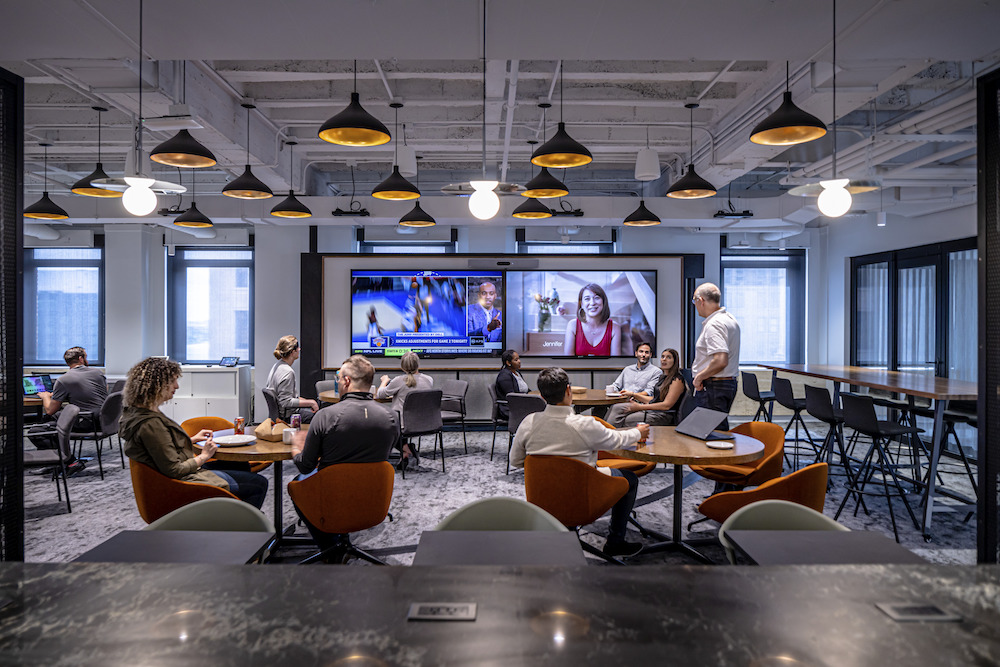Amy Clark and Bob Varga of SmithGroup explore the importance of organizational experimentation in 2022.
– Stay tuned as we share more 2022 workplaces trends for the entire month of December –

We’ve all seen the stats.
During this transformative time, many organizations plan to expand their hybrid work model, where employees will work on-site in the office some of the time and work remotely some of the time. And while this idea of hybrid work is gaining widespread traction, it is imperative to understand that not all hybrid workers are the same. Some team members might only work in the office a few days a month, while others may come in regularly four days a week. While both hybrid workers, their needs vary greatly.
At this point, most remote employees have effectively navigated their home office set-up and have the proper technology in place to productively complete their work. But have organizations successfully developed their hybrid management strategies? For progressive companies, 2022 will be a time to systematically design and test many of the operational components of their hybrid work system. In addition to determining how their hybrid work is designed, this could also include management tools, team schedules and meeting protocols.
Historically, “management by wandering around” (MBWA) had been a widely adopted and largely accepted management style. Over the course of the pandemic, as work transitioned from the office to individuals’ homes, leaders could no longer physically see or hear their employees, thus rendering the MBWA technique obsolete. For the hybrid work model to be both successful and sustainable, organizations must learn how to effectively guide both in-person and remote workers–simultaneously.

Fail Fast. Iterate. Experiment.
Whatever process or language an organization chooses, the philosophy remains unchanged and iterative. Strategically try new approaches, then carefully evaluate, retest, and refine them yields better outcomes more quickly. This experimentation mindset is particularly valuable during times of large uncertainty. Given how rapidly our workplaces have transitioned, this iterative process could prove useful to help companies transform and produce their best work. Models for this type of reasoning include the scientific method and the design thinking process.

As Figure 1 illustrates, the design thinking process (as used by many institutions and practitioners) consistently narrows the quantity of possible solutions throughout the process, while continually expanding the depth of the solution. For example, during the early design phases, a wide net is cast, where designers gather research and look at a wide range of potential solutions. Those options are then tested against variables such as viability, budget and how well the scenarios support the clients’ organizational objectives. In further phases, numerous design iterations are developed with more parameters added to the field, then evaluated and tested. How well does a particular solution respond to specific design criteria? Are all the design requirements met? Does the solution align with and support the clients’ brand? This process of iterating and narrowing the breadth of possible solutions while increasing the depth continues until project completion. These iterative and experimental processes are not completely linear. There may be starts and stops as some parts of a design may quickly progress, while others may take longer to develop. But the principle remains – iterate quickly and then intentionally evaluate and test those scenarios for further refinement.
The critical phase of the process isn’t just running the test, but also intentionally gathering feedback, determining what works and doesn’t, refining the test, and then retesting. This type of experimentation could be extremely successful when positioned as a top-down AND bottom-up proposition. Meaning that leadership may create some guidelines and provide support for the program, and then individual teams would test, refine, and report out what they have learned back to the broader organization.

The success or failure of a company’s hybrid work platform will hinge on how well teams are able communicate, brainstorm, and develop new ideas–while allowing employees to do their best work whether they are in the office or working remotely. There is an opportunity for this new way of working to provide even better outcomes than pre-pandemic work models. Heading into 2022, the entrepreneurial organizations will stay scrappy, run pilot programs for new modes of working and capitalize on this transformative time.
Stats from graphic:
2012: 39% of workers spent some of their time working remotely[1]
2016: 43% of workers spent some of their time working remotely[2]
2021: 67% of workers spent all of their time working remotely[3] [4]
[1] https://www.gallup.com/workplace/283985/working-remotely-effective-gallup-research-says-yes.aspx
[2] https://www.gallup.com/workplace/283985/working-remotely-effective-gallup-research-says-yes.aspx
[3] https://www2.deloitte.com/content/dam/Deloitte/us/Documents/human-capital/us-2021-return-to-workplaces-survey.pdf
[4] These numbers refer to knowledge-based workers that are eligible for remote work. About 15% of our labor force (totaling 22.2 million jobs filled 2/3 by women) is comprised of low-paying jobs that often lack benefits or flexible scheduling. (https://nwlc.org/wp-content/uploads/2020/04/Women-in-Low-Paid-Jobs-report_pp04-FINAL-4.2.pdf)

